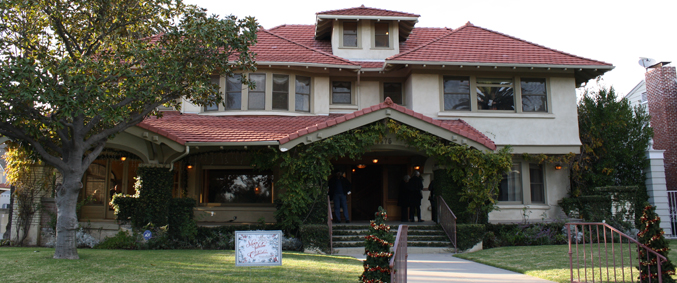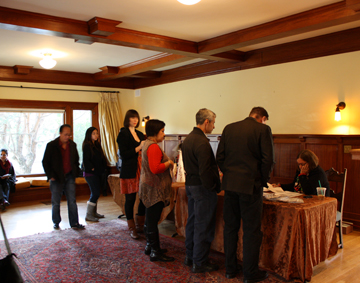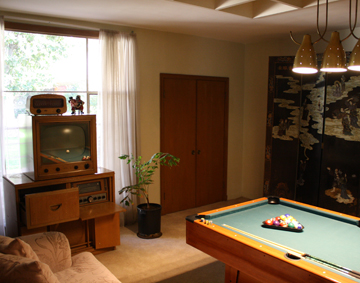Marilyn Monroe’s Grandmother, Buster Keaton’s Cameraman Join Vaudeville and Jazz Age Performers on this Unique Outdoor “Stage”
Flappers, singers, dancers, magicians, and even a celebrity chef – a host of colorful entertainers rest at Angelus Rosedale Cemetery, one of the city’s oldest, most historically significant cemeteries.
On Saturday, September 29, at the 22nd annual Living History Tour, visitors will “meet” some of Los Angeles’s most interesting early performers and entertainment industry personages as costumed actors, at graveside, portray the lives of a Civil War-era escape artist, a headlining dancer who lost her life in the 1933 Long Beach earthquake, a mezzo soprano who fought for civil rights, and a Chinese-American dancer/actor/MC, among other quirky and wonderful characters. Tours depart every 25 minutes from 9:00 a.m. to 12:00 noon. Advance reservations are required.
This year’s tour commemorates not only Los Angeles’s longtime role as the center of this country’s entertainment industry, but also the roles several of these personages played in the larger history of civil rights. In addition, the tour memorializes the 150th anniversary of the Civil War (1861-1865).
This year’s portrayals include:
• Della Hogan Monroe, Marilyn Monroe’s colorful grandmother; a religious devotee, Mrs. Monroe had baby Norma Jean baptized at the Hawthorne Foursquare Church in 1926;
• Victor Dol, L.A.’s first chef trained in Paris, who opened an elegant French restaurant in 1876 that soon earned the nickname “Delmonico’s of the West”;
• Rita Carewe, a Jazz Age starlet and “Baby WAMPAS” (Western Association of Motion Picture Advertisers) winner who appeared in films with Delores del Rio, Edward Everett Horton, and Mary Pickford;
• Sadie Cole, a Fisk Jubilee singer and a civil rights activist who helped desegregate L.A.’s cafes and beaches;
• Byron Houck, baseball pitcher for the 1913 World Series Philadelphia A’s, who later became Buster Keaton’s cameraman on “The General.” Houck was the Vernon Tigers’ ace pitcher when the team was owned by Roscoe “Fatty” Arbuckle;
• Mildred Washington, a vaudeville dancer and choreographer who headlined at Sebastian’s Cotton Club in Los Angeles;
• Harry Cooke, Magician and Civil War Union Army “scout” who was America’s first Escape Artist;
• Honorable Wu (Harry Gee Haw), actor, singer, dancer, and vaudeville impresario known as “The Broadway Mandarin.”
Angelus Rosedale Cemetery was founded in 1884, and is now home to many generations of Los Angeles’s citizens, representing every race, faith, and creed. Each year, West Adams Heritage Association (WAHA) tells some of their life stories while touring the historic grounds and elaborately carved monuments of L.A.’s first lawn cemetery.
TICKET SALES/TOUR TIMES
Advance Ticket Sales Only—No Walk-ins! $25 in advance, paid by September 24. $35 after that or on day of tour, space permitting. (Children under 10 attend free.)
Tours depart approximately every 25 minutes, beginning at 9 a.m., with the last tour at noon. The public is invited. Tickets are by ADVANCE RESERVATION ONLY; each tour has a limited number of spaces. The Living History Tour is a three-hour docent-led walk through the cemetery, over uneven terrain; visitors are advised to wear appropriate clothing and walking shoes.
Address: 1831 West Washington Blvd., Los Angeles, CA 90007.
For tickets and information, log onto www.WestAdamsHeritage.org. 323-732-4223 or tours[at]westadamsheritage.org.
The tour will raise funds for the West Adams Heritage Association, a nonprofit organization that was founded in 1983 to support preservation of the community’s architectural and cultural heritage. WAHA has grown from a small resident support group to a recognized preservation voice with hundreds of members who live in the many neighborhoods of the Historic West Adams District.










 Later in the evening, groups gathered at the Welcome House for the start of the progressive dinner. Volunteers from WAHA led them through each course of the meal which was set up in a different house; from the Atomic-Age Appetizer House through the Salad and Dinner Houses, ending finally at a Spanish-style villa serving as the Dessert House.
Later in the evening, groups gathered at the Welcome House for the start of the progressive dinner. Volunteers from WAHA led them through each course of the meal which was set up in a different house; from the Atomic-Age Appetizer House through the Salad and Dinner Houses, ending finally at a Spanish-style villa serving as the Dessert House. The Appetizer House is one example of this honesty. The swanky Atomic-Age residence is a Paul Williams design officially known as the Taylor Residence.
The Appetizer House is one example of this honesty. The swanky Atomic-Age residence is a Paul Williams design officially known as the Taylor Residence.  In 1983, WAHA was founded as a neighborhood association. Noticing that the majority of people moving into the area had an interest in historic homes, WAHA morphed into a preservation advocacy group.
In 1983, WAHA was founded as a neighborhood association. Noticing that the majority of people moving into the area had an interest in historic homes, WAHA morphed into a preservation advocacy group.




